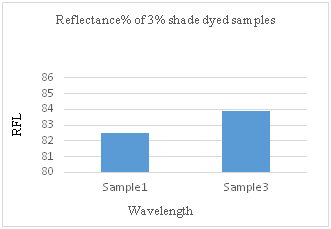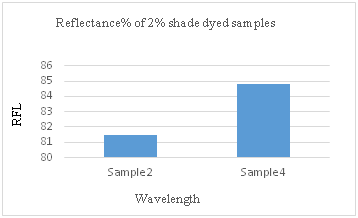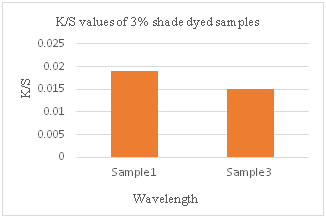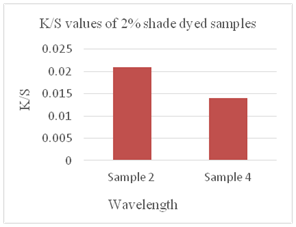Journal of
eISSN: 2574-8114


Research Article Volume 5 Issue 6
1Department of Fabric Manufacturing Engineering, Textile Engineering College, Noakhali affiliated by Bangladesh University of Textiles, Bangladesh
2Department of Wet Processing Engineering, Textile Engineering College, Noakhali affiliated by Bangladesh University of Textiles, Bangladesh
Correspondence: Sakib Mahmud Surid, Department of Wet Processing Engineering, Textile Engineering College, Noakhali affiliated by Bangladesh University of Textiles, Dhaka- 1208, Bangladesh, Tel +880 1521441777
Received: October 31, 2019 | Published: November 18, 2019
Citation: SolaimanMD, Surid SM, Patwary MAS, et al. Dyeing of cotton fabric with ground water and sea water: comparison of their fastness properties. J Textile Eng Fashion Technol. 2019;5(6):276-282. DOI: 10.15406/jteft.2019.05.00213
A little variation in dyeing procedure applied when fabric dyed with ground water and sea water. When ground water from natural sources used as dyeing medium wetting agents, sequestering agents, anti- creasing agents, salt, soda everything were applied to complete dyeing process. But in case of sea water we didn’t apply sequestering agents so that the hardness of sea water might not be broken. Again Bay of Bengal water contains a lot of salts, so it wasn’t needed to use salts for dyeing with sea water. The main purpose of our research was to find out the differences in several physical and chemical properties of dyed fabrics and to determine whether can be used sea water as dyeing medium for dyeing process. Sea water is available in Bangladesh. Again due to lack of ground water availability the layer of our ground water falls down every year. So, it has become a crying need to find out another alternative source of water to continue our industrial dyeing process. For this purpose we wanted to find out the possibilities and opportunities of using sea water as dyeing medium instead of ground water.
Keywords: cotton, ground water, sea water, reactive dye, shade variation, reflectance %, color fastness, color strengthWater, a substance composed of the chemical elements hydrogen and oxygen and existing in gaseous, liquid, and solid states. It is one of the most plentiful and essential of compounds. Processes such as mining, chemical pulping, pulp bleaching, paper manufacturing, textile production, dyeing, printing, and cooling of power plants use large amounts of water, requiring a dedicated water source, and often cause significant water pollution. Water is used extensively throughout textile processing operations. The Textile industry is dependent on water in virtually all steps of manufacturing. Textile industry is the third largest consumer of water in the world. Wet processing engineering is one of the major streams in textile engineering. In every stages of wet processing huge amount of water is used. Most fabric preparation steps, including desizing, scouring, bleaching and mercerizing use water. According to the latest FAO data on sectoral water use, Bangladesh total annual freshwater withdrawal in 2014 was 35.87 billion cubic meter in which total industrial water use only accounted for about 2.147% of Bangladesh total water use, while agricultural sector is the largest water use with 87.82% followed by domestic water use of 10.04%. It is projected that industrial water demand can increase by 109%, domestic water demand by 75% and agricultural water demand by 43% in 2030.1 Textile and RMG industry is the main contributor to that industrial water demand. Most industrial water is sourced from groundwater (estimated at 98%2). About 90% of urban water supply is also sourced from groundwater.3 From a report on Daily star newspaper, it is seen that, the groundwater level in the capital has dropped by six meters in the last seven years.4 The main purposes of using sea water as dyeing medium are to reduce the use of ground water and reduction in requirement of sequestering agents and salts. In this work, it can also be seen that reducing the dependency on ground water and instead of ground water how successfully a dyeing process of cotton fabric with reactive dye can be done by using sea water. Dyeing of cotton fabric with sea water is one of the possible options to reduce the dependency on the ground water. Sea water was collected from cox’s bazar sea beach used as raw with pH of 7-8, hardness was about 3.94g/L and TDS was 20920 PPM (2100g/L). The six most abundant ions of seawater are chloride (Cl), sodium (Na+), sulfate (SO24−), magnesium (Mg2+), calcium (Ca2+), and potassium (K+). By weight these ions make up about 99% of all sea salts. Seawater contains more dissolved ions than all types of freshwater.5
However, the ratios of solutes differ dramatically. For instance, although seawater contains about 2.8 times more bicarbonate than river water, the percentage of bicarbonate in seawater as a ratio of all dissolved ions is far lower than in river water. Bicarbonate ions constitute 48% of river water solutes but only 0.14% for seawater.5,6 Differences like these are due to the varying residence times of seawater solutes; sodium and chloride have very long residence times, while calcium (vital for carbonate formation) tends to precipitate much more quickly.7 The most abundant dissolved ions in seawater are sodium, chloride, magnesium, sulfate and calcium.8 In this study, we have analyzed the influenced of sea water and ground water during the dyeing process of the samples. The main target of the work was how we can reduce using of ground water during dyeing.
Materials
For this experiment, we used 100% single jersey cotton fabric of 140GSM, count of yarn was 30/1, and stitch length was 2.6mm. Fabrics for the dyeing of samples were collected from Interstoff Apparels Limited, Chandra, Gazipur, Dhaka, Bangladesh. Two types of water were used for the experiment, one using sea water was collected from the Bay of Bengal off the South East coast of Bangladesh with pH of 7-8, hardness is about 3.94g/L and TDS is 20920 PPM (2100 g/L). The final target of this work was to compare the effects of fastness properties between dyed fabric with normal water and dyed fabric with sea water. Color fastness tester, Beesley’s balance, Crocking meter, Stop watch, ICI pilling tester and Spectrophotometer were used to do the physical, mechanical and visual properties of the 100% cotton single jersey fabric. In the pretreatment stage of dyeing, Wetting agent (Deterpal HW), sequestering agent (Sequestrante 549), Anti-creasing agent (Novolube PAN 200), Stabilizer (Perox PAG), Sodium Hydroxide (Natrium Hydroxide), H2O2 (Product BSS), Soda ash (Natrium-bi-carbonate), Peroxide killer (Oxitase Kp) and Acetic acid were used. For the dyeing stage and the after treatment stage respectively Ground water, Sea water from Bay of Bengal, Wetting agent (Deterpal HW), sequestering agent (Sequestrante 549), Anti-creasing agent (Novolube PAN 200), Scarlet Dye (Scarlet 3GF), Levelling agent(Permacol RK), Glauber salt, Soda ash and Acetic acid, Detergent (Deterpal HW), Fixing agent (Novofix CT/HYP) were also used.
Methods of the experiments
Scouring and bleaching process of cotton fabric: Set the bath with substrate at room temperature with wetting agent, sequestering agent and anti-creasing agent. Then load 40gm 100% cotton single jersey fabric in the pot. After 5 minutes added soda ash and NaOH. Again after 5 minutes added H2O2 and raised the temperature to 100˚C. After reaching 100˚C temperature, run for 40 minutes at the same temperature. After that lowered the temperature at 50˚C and rinsed for 10 minutes then dropped the liquor. Again raised the temperature at 80˚C gradually, applied H2O2 killer and run for 10 minutes. After then lowered the temperature at 50˚C and rinsed for 10 minutes. Finally treated the sample with acetic acid for 10 minutes at 60˚C temperature to make the sample neutral and then rinsed with cold water again (Figure 1).
Dyeing with ground water: At first in room temperature, ground water, wetting agent, sequestering agent and anti-creasing agents were mixed in dyeing bath. Then fabric sample was immerged here. Dyes mixed in the dyeing bath. Temperature was increased gradually up to 80˚C. Salt was added when temperature increasing. At 80˚C temperature, soda ash dosed and run about 60 minutes. Then cool down the bath and rinsed fabric at 50˚C. Fabric was treated with Acetic acid to neutralize it. Then temperature increased and at 90˚C, detergent was added. Then rinsed the fabric at 50˚C temperature. After all fixing agent was mixed in dye bath at 60˚C temperature for 10 minutes to fix the dye molecules with fabric (Figure 2).
Dyeing with sea water
At first in room temperature, sea water, wetting agent and anti-creasing agents were mixed in dyeing bath. Then fabric sample was immerged here. Dyes mixed in the dyeing bath. Temperature was increased gradually up to 80˚C. At 80˚C temperature, soda ash dosed and run about 60 minutes. Then cool down the bath and rinsed fabric at 50˚C. Fabric was treated with Acetic acid to neutralize it. Then temperature increased and at 90˚C, detergent was added. Then rinsed the fabric at 50˚C temperature. After all fixing agent was mixed in dye bath at 60˚C temperature for 10 minutes to fix the dye molecules with fabric (Figure 3).
Test procedures
Testing procedure of reflectance % of dyed samples: The reflectance percentages of ground water dyed samples and sea water dyed samples were measured and compared using a UV VIS-NIR reflective spectrometer (Spectra Flash SF 600 X, USA), over the range of 400nm to 700nm.
Testing procedure of color strength: The color intensities of ground water dyed fabric and sea water dyed fabric for a specific design and construction, fabrics were measured and compared using a UV VIS-NIR reflective spectrometer (Spectra Flash SF 600 X, USA), over the range of 400nm to 700nm.
Testing procedure of colorfastness to rubbing (ISO 105X12; 1993; BS EN ISO 105X12; 1995)
Test specimen: Two pieces of 14cm×5cm specimens are required for dry rubbing and two for wet rubbing test.
Test procedure
Dry rubbing test: Lock the test specimen onto the base of the Crockmeter so that it lies flat and taut for test and taut for testing. Using the spiral clip, set a 5cm×5cm square of the white rubbing test cloth to set the finger of the Crockmeter. Lower the covered finger onto the test sample. Turn the hand crank and make ten complete turns of the crank, at the rate of one turn per second. Remove the white rubbing test specimen cloth from the finger and evaluate color transfer using the gray scale for staining under standard lighting, D65.
Wet rubbing test: Repeated the procedure on another sample with the white test cloth wetted in distilled water. Ensured that the rubbing test cloth would be wetted with water to 100% take up. Air dried the 100% cotton single jersey test cloth at the room temperature before evaluation.
Testing procedure of color fastness to washing (ISO 105 C06)
Test specimen: Sample Fabric: 10cm×4cm
Multi fiber fabric: 10cm×4cm
Test procedure
Collect the sample from bulk and then conditioning for 04:30 hours to 06 hours. Make a specimen of 10cm×4cm in size. Sew the specimen with multi-fiber fabric of same size at one corner. Make the solution of 4gm/ litre ECE detergent & 1gm/litre sodium perborate. Put the specimen with multi-fibre fabric into the solution in Rotary washing m/c and taking temp: 60˚C at 30 min with 25pcs still ball. Rinse with hot water respectively. Squeeze with cold water of the sample is done (Hand Wash). Then drying is done at a temperature in the air not exceeding 60˚C. The stitching is then broken out except on one of the shorter end. Measure the staining and color change by grey scale & make a test report.
Testing procedure of pilling test (ICI Pilling Box) (ISO 12945-1)
Test Specimen: Sample Fabric: 5”×5”
Test procedure
The sample is sewn so as to be firm fit when placed a rubber tube 6” long, 1.25” outer diameter and 0.125” thick. The cut ends of the fabric are covered by cellophane tape and 4 tubes are placed in a box (9”×9”×9”) lined with cork 0.125” thick. The box containing the tube is then rotated at 60rpm for 5 hours. After tumbling, the extent of pilling assessed visually comparison with the arbitrary standards.
Testing procedure of water takes up percentage (ASTM D-570)
Test specimen: Make a sample at a dimension of 2cm in length×1cm in width.
Test procedure
Composite samples were immersed in a beaker containing 100ml of deionized water at room temperature for 1 hour. Initially, weight of samples was determined, after certain time interval; samples were taken out of the beaker and wiped using tissue papers. Their weight was taken again. In this case, it shows no uptake after 40 minutes; that why carried out the test up to 1 hour water uptake percentage was determined by using following equation- Water take up percentage = [Wet weight–Dry weight)/Dry weight]×100.
Comparison on shade%
Table 1 showed the dyeing recipe and the shade of each samples dyed with ground water and sea water. The evaluation had been done under D65 light source in the light box. Reactive dyes of cold brand, salt and soda used amount had been mentioned on the table. The amount of salt and soda were calculated according to shade % those are practically used for the laboratory dyed samples.
Recipe |
Ground water dyed samples |
Sea water dyed samples |
Scarlet 3GF- 3% |
|
|
Wetting agent- 1g/L |
||
Sequestering agent- 0.5g/L (sample 1) |
||
Anti-creasing agent- 1g/L |
||
Salt- 80g/L(sample 1) |
||
Soda ash- 20g/L |
||
Scarlet 3GF- 2% |
|
|
Wetting Agent- 1g/L |
||
Sequestering agent- 0.5g/L (sample 1) |
||
Anti-creasing agent- 1g/L |
||
Salt- 50g/L(sample 1) |
||
Soda ash- 12g/L |
Table 1 Dyeing recipe and comparative shade between the samples
Obtained reflectance percentages are plotted on graph for sample 1, 2, 3, 4 (Figure 4) (Figure 5). Sample 1 and 3 showed reflectance for dark shade and sample 2 and 4 showed reflectance for medium shade of fabrics dyed with ground water and sea water respectively. Considering dark shades sample 1 showed reflectance value 82.469% where the value increased about 1.77% in case of sea water (sample 3).Again for medium shades sample 2 showed reflectance value 81.494% where the value increased about 4.09% in case of sea water (sample 4).Reflectance values increases for sea water dyed samples comparing with ground water dyed samples.

Figure 4 Graphical representation of reflectance% of 3% shade dyed samples with respectively ground water and sea water.

Figure 5 Graphical representation of reflectance% of 2% shade dyed samples with respectively ground water and sea water.
K/S values of dyed samples
Obtained K/S values are plotted on graph for samples 1, 2, 3 and 4 (Figure 6) (Figure 7). For dark shades, we found K/S value 0.019 when using ground water (sample 1) and the value found 0.015 when using sea water (sample 3). Again considering medium shades, we found K/S value 0.021 in case of ground water(sample 2) and the value showed 0.014 for sea water as dyeing medium(sample 4). K/S values decreases for sea water dyed samples comparing with ground water dyed samples.

Figure 6 Graphical representation of k/s of 3% shade dyed samples respectively with ground and sea water.

Figure 7 Graphical representation of k/s of 2% shade dyed samples respectively with ground and sea water.
Determination of colorfastness to rubbing
This test was designed to determine the degree of color which may be transferred from the surface of a colored fabric to specify test cloth for rubbing (which could be dry and wet).
From the both samples, it was seen no staining at dry condition and at the wet condition, very slight staining was seen for both samples. 100% cotton single jersey fabric of 140 GSM was dyed with reactive dye. First sample was dyed using ground water showed the excellent fastness quality at the dry condition and the second sample was dyed using sea water showed also excellent fastness at the dry condition. But at the wet condition, first sample wherein ground water was used as liquor showed not excellent but good fastness quality. Same as at the wet condition, second sample wherein sea water was used as liquor showed good fastness quality (Table 2).
Sl. No |
Dry condition rubbing result |
Wet condition rubbing result |
||
Ground water dyed samples. |
Sea water dyed samples. |
Ground water dyed samples. |
Sea water dyed samples. |
|
1 |
5 |
5 |
4/5 |
4/5 |
2 |
5 |
5 |
4/5 |
4/5 |
Average |
5 |
5 |
4/5 |
4/5 |
Table 2 Results of colorfastness to rubbing of the samples
From the Table 3 and Table 4, it was found that dyes stained on the fibers of the multifibre fabric showed the rating was almost same for both fabrics. The staining on the di-acetate, bleached cotton, polyester, acrylic for 100% cotton single jersey fabric dyed with reactive dye with ground water and sea water both showed almost the same result. There was seen no staining on the polyamide for the samples wherein used ground water as liquor. But the staining on the polyamide for the samples wherein sea water used as liquor was slightly and fastness quality was moderate to good. For the both liquors i.e. ground water and sea water, the staining on the wool was same; moderate to good in fastness quality.
Multifibre’s layer |
Sample 1 |
Sample 3 |
Di-acetate |
4/5 |
4/5 |
Bleached cotton |
4/5 |
4/5 |
Polyamide |
5 |
4 |
Polyester |
4/5 |
4/5 |
Acrylic |
4/5 |
4/5 |
Wool |
4 |
4 |
Table 3 Results of Color staining of 3% shade dyed samples respectively with ground and sea water
Multifibre layers |
Sample 2 |
Sample 4 |
Di-acetate |
4 |
4/5 |
Bleached cotton |
4/5 |
4/5 |
Polyamide |
5 |
4/5 |
Polyester |
4 |
4/5 |
Acrylic |
4/5 |
4 |
Wool |
4 |
4 |
Table 4 Results of color staining of 2% shade dyed samples respectively with ground and sea water
Considering dark shade samples (Figure 8), it was seen that the rating of pilling was 1 for both the ground water dyed sample and sea water dyed sample, which indicates no pilling was formed. Again for medium shade samples (Figure 9) the rating was 2 for both the ground water dyed sample and sea water dyed sample, which indicates slight but tolerable piling.
Determination of water takes up percentage
From Table 5 and Table 6, it was seen that water take up % of ground water dyed sample was greater than sea water dyed sample because fabric resisted a small volume of sea water cause of some particles of sea water couldn’t penetrate into the fabric.
Samples |
Dry weight |
Wet weight |
Water take up % |
Sample 1 |
2gm |
4.40gm |
120% |
Sample 3 |
2gm |
4.19gm |
109% |
Table 5 Results of water take up% of 3% shade dyed samples with respectively ground and sea water
Samples |
Dry weight |
Wet weight |
Water take up % |
Sample 2 |
1.5gm |
3.30gm |
120%% |
Sample 4 |
1.5gm |
3.05gm |
103% |
Table 6 Results of water take up% of 2% shade dyed samples with respectively ground and sea water
In this research we had analyzed several properties of dyed samples where dyeing mediums were ground water and sea water respectively. We have found a little bit of shade variation when fabric dyed with ground water and sea water. Fabric dyed with ground water showed better shade percentage due to higher penetration of dye molecules into fabric samples than sea water dyed samples. Sea water dyed samples reflected more lights than ground water dyed samples i.e. they showed more reflectance. But K/S values found more in case of ground water dyed samples. Color fastness to rubbing was almost same for the samples dyed with ground water and sea water. No problem seen about color fastness to washing. The fastness showed by sea water dyed samples almost same to the fastness showed by ground water dyed samples. In case of dark shades both samples showed better resistance to pill and for medium shades both samples showed a slight tendency to form pill for both samples. Samples dyed with ground water showed better water take up percentage and more tendencies to swell than samples dyed with sea water.
None.
None.
The authors declare that they have no competing interests.

©2019 SolaimanMD,, et al. This is an open access article distributed under the terms of the, which permits unrestricted use, distribution, and build upon your work non-commercially.